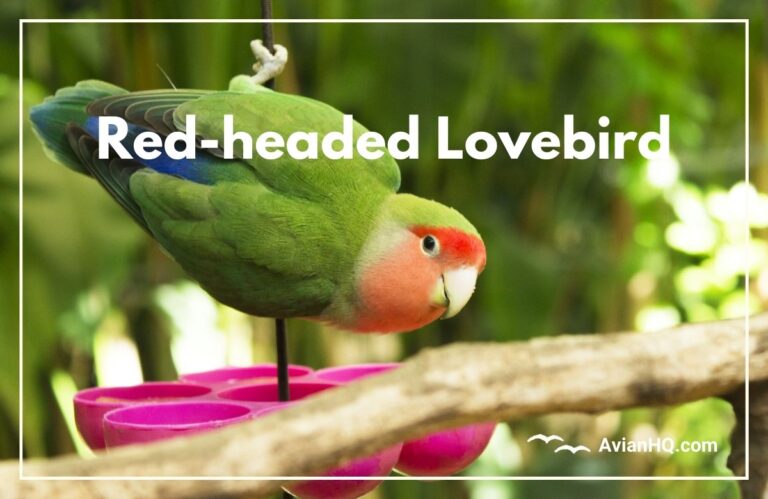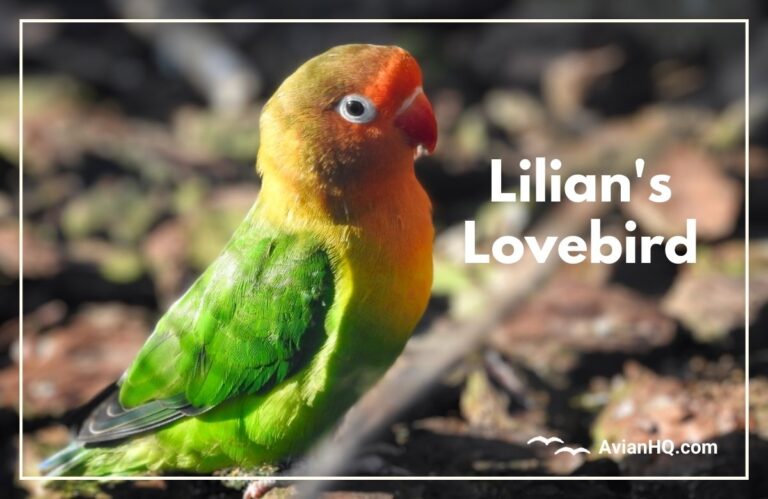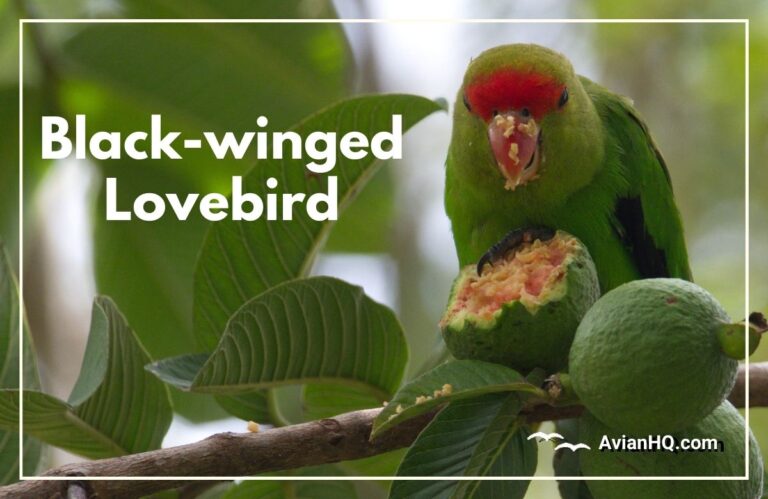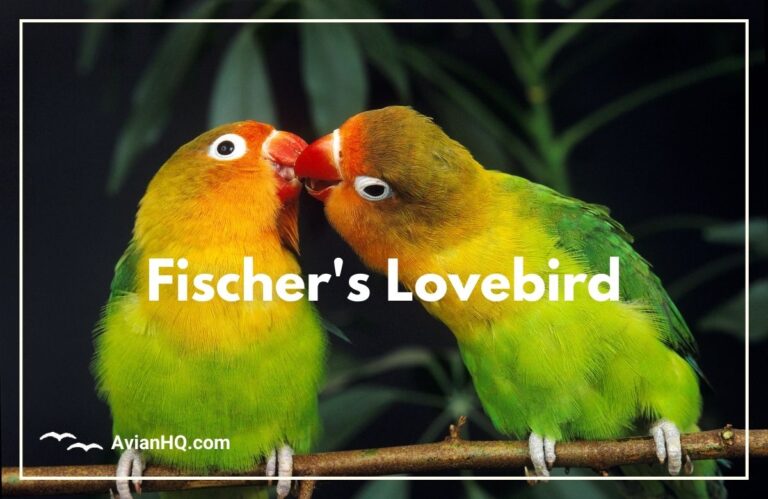Black-cheeked Lovebird (Agapornis nigrigenis)
The Black-cheeked Lovebird is a small, striking parrot native to a tiny region of Africa. When you first glimpse one, you’ll likely notice the deep russet forehead and jet black cheeks contrasting vividly with bright green plumage. A splash of orange below the chin and white rings around the eyes add to the colorful palette.
Weighing less than 2 ounces (50 grams), these petite parrots measure approximately 5.5 inches (14 centimeters) from head to tail. They may be tiny, but Black-cheeked Lovebirds have huge personalities! Their loud voices and acrobatic antics endear them to bird enthusiasts around the world.
Sadly, wild Black-cheeked Lovebird numbers have declined significantly in recent decades. With their survival dependent on a very specific habitat, the species is extremely vulnerable to threats like drought, habitat loss, and trapping for the pet trade. Classified as Vulnerable on the IUCN Red List, between 2,500-9,999 mature adults remain in the wild.
Captive breeding programs and conservation efforts currently underway provide hope for the future. However, the outlook remains uncertain for these charming African parrots. Understanding their unique traits and specialized needs is key to supporting both captive and wild populations.
History and Taxonomy
The Black-cheeked Lovebird was first discovered by Europeans in the early 1900s in southwestern Zambia. For years it was considered a race of the closely related Lilian’s Lovebird, rather than its own distinct species. Ornithologists eventually recognized it as a separate species, bestowing the scientific name Agapornis nigrigenis.
The genus name Agapornis derives from Greek roots meaning “love bird.” The species name nigrigenis refers to the bird’s defining feature – its black (niger) cheeks (genis). No differentiated subspecies of the Black-cheeked Lovebird have been identified. However, some experts believe occasional hybrids may occur between Black-cheeked Lovebirds and Masked Lovebirds in the wild.
So far, no color variants or mutations have been officially documented in Black-cheeked Lovebirds either. Unsubstantiated rumors exist of a strking blue mutation, though proof remains elusive. For now, the single nominate race exhibits consistent predominantly green and brown plumage in the wild and in captivity. Their distinctive facial markings serve to identify the Black-cheeked Lovebird as a species apart, no matter its surroundings.
Physical Appearance
The Black-cheeked Lovebird cuts a diminutive but vivid figure. Measuring about 5.5 inches (14 centimeters) long, these petite parrots typically weigh around 38 grams (1.3 ounces) for males and 43 grams (1.5 ounces) for females. Plumage consists primarily of green feathers, darker on the back and lighter on the chest and belly.
The face provides the most dramatic markings. A dark brownish-red cap extends from the top of the crown down to the nape, while the forehead, lores, cheeks, and throat are cloaked in blackish-brown to jet black feathers. This dark facial mask contrasts sharply with bright green feathers on the sides of the neck.
An orange-red bib under the chin stands out brightly and fades gradually into the yellow-green hues of the breast. White feathers form distinct rings around the eyes. The eyes themselves are dark brown to black, while the legs and feet are grayish in color. The beak matches the bib in a vivid orange-red hue.
Juvenile Black-cheek Lovebirds resemble the adults, but have darker underparts and an orange or grayish beak that later turns red. No significant differences exist between the males and females of the species. Their diminutive stature and dramatic facial markings make the Black-cheeked Lovebird a distinctly charming bird.
Habitat and Distribution
The Black-cheeked Lovebird resides only in a small swath of southwestern Zambia in Africa. Its restrictive range spans between the Kafue River north to the Zambezi River south. This area encompasses parts of Lochinvar National Park and the Kafue Flats wetland region.
Within its narrow habitat zone, Black-cheeked Lovebirds occupy savanna and wooded areas dotted with grasslands. They are most often found in stands of mopane and acacia trees near water sources such as rivers or marshes. Their favored habitats sit at elevations between 600-1000 meters (1968-3280 feet) above sea level.
Ranked as one of Africa’s rarest parrots, the Black-cheeked Lovebird has no introduced stable populations elsewhere in the world. However, aviculturalists and collectors in North America, Europe, and Japan occasionally breed captive specimens. For wild Black-cheeked Lovebirds though, suitable habitat exists only in their native range in Zambia.
Conservation efforts strive to protect critical areas like Lochinvar National Park that preserve essential habitat for this diminutive parrot. Maintaining the unique grassland and wetland ecosystems this species relies on will be key to its future survival.
Diet and Feeding
In the wild, Black-cheeked Lovebirds feed primarily on the ground in small flocks or pairs. Their diverse diet includes a wide variety of both plant and animal matter.
Grasses supply important seed components. The lovebirds forage on seeds from grass species such as Hyparrhenia and Eragrostis. They also feed on cereal grains like corn, millet, and sorghum, likely scavenging from agricultural areas near their habitat.
Other vegetable matter includes berries, buds, leaves, flowers, and fruits. Figs, in particular, draw large gatherings of Black-cheeked Lovebirds and other African parrots. To obtain minerals, the lovebirds supplement with clay licks in streambeds.
Animal protein enters the diet via insect larvae gleaned from the environment. Although the Black-cheeked Lovebird’s small bill limits foraging for insects, larvae likely supply crucial nutrients for breeding birds and growing chicks.
In captivity, the staple diet consists of a quality seed mix with added vegetables, fruit, greens, sprouts. A complete pelleted ration may also be offered. Clean drinking water should be constantly available. Feeding a varied diet will help ensure pet Black-cheeked Lovebirds thrive. Monitoring their intake of high fat seeds is wise to maintain optimum health.
Breeding and Reproduction
In the wild, Black-cheeked Lovebirds nest in the hollows of large mopane and acacia trees. The birds breed colonially, with many pairs congregating in the same group of nest sites.
The breeding season spans from November through December, coinciding with the rainy period in southern Africa. Pairs will aggressively defend their chosen nest hollow from other lovebirds or competitors.
A clutch consists of 3-6 white eggs which are cared for solely by the female for about 23 days. Meanwhile, the male passes food to her during incubation. After hatching, both parents share duties feeding the young nestlings.
The helpless chicks remain in the nest for about 5-6 weeks, fledging once they are strong enough for flight. Juvenile lovebirds initially resemble adults, but take on full adult plummage after their first annual molt. Young Black-cheeked Lovebirds reach sexual maturity for breeding at around 2-3 years of age. With attentive care, they may live for 15-20 years or more.
In captivity, pairs are best bred in separate enclosures away from other birds. Providing a secluded nest box increases chances for success. Parent-raised chicks make the best pets thanks to proper socialization. Following the wild breeding timeline helps captive Black-cheeked Lovebirds thrive.
Behavior and Ecology
Extremely social by nature, Black-cheeked Lovebirds congregate in small flocks ranging from pairs up to groups of 100 or more birds. They will forage, roost, bathe, and fly together, perhaps finding safety in numbers.
Flocks roam over a large terrain in search of scattered food resources. They regularly gather at favored water and clay lick sites, chattering excitedly with their distinctive screeching calls. Lovebird pairs preen each other frequently, strengthening lifelong pair bonds. They may also join in impressive synchronized flock displays.
Within flocks, competition occurs for choice nesting sites during breeding season. Monogamous pairs defend their nest hollows fiercely. However, groups will still forage cooperatively and share communal roosts throughout the year.
Drought impacts flock behavior, as dwindling water supply forces larger aggregations at remaining pools. Deforestation also overcrowds suitable habitat, increasing conflict. Despite being Africa’s smallest parrots, Black-cheeked Lovebirds clearly find strength in sticking together even when resources run scarce. Their social bonds showcase the loving spirit that gives this diminutive parrot its name.
Conservation Status
The restricted habitat range and small global population has led the International Union for Conservation of Nature (IUCN) to classify the Black-cheeked Lovebird as Vulnerable on the Red List of Threatened Species.
Recent surveys suggest only 2,500-9,999 mature adults remaining in the wild. However, obtaining accurate counts proves difficult. What is certain is that the numbers continue to decline as threats mount against this rare African parrot.
The primary dangers all relate to disturbances within their specialized habitat. Continued deforestation of mopane woodlands leaves fewer trees suitable for nesting. Conversion of wetlands to agricultural farms removes crucial foraging grounds.
Ongoing drought conditions in the region have dried up water sources and grasslands. This forces lovebird flocks to concentrate in limited spaces, increasing competition for scarce resources. Capture for the live bird trade only exacerbates dwindling native populations.
Conservation efforts are underway to preserve habitats in national parks and protected wetland preserves. Ecotourism may also aid communities coexisting near lovebird grounds. However, the ultimate fate of the species weighs heavily upon maintaining the fragile ecosystems this tiny parrot relies so closely upon. With dedicated human commitment, we can ensure Black-cheeked Lovebirds continue charming the African landscapes for generations to come.
Cultural Significance
The small native range and elusive nature of the Black-cheeked Lovebird has limited its significance in local folklore or culture. They do not feature prominently in the mythological stories or artwork of African tribes in the region.
However, the vibrant parrots may potentially hold untapped tourism value. Birdwatchers already rank seeing the rare lovebirds as a top wildlife viewing priority. As part of guided visits to protected reserves, visitors could support local communities while sustaining critical lovebird habitat.
The Black-cheeked Lovebird also serves as Zambia’s national bird along with the African fish eagle. Images of the colorful parrots represent the country in logos, maps, postage stamps and more. Efforts to preserve wild populations therefore relate directly to national pride and identity.
Beyond African borders, the Black-cheeked Lovebird is slowly gaining popularity in the international aviculture trade. Its lively antics and devoted bonds with mates are winning fans worldwide. Zoos, aviaries and private collectors are gradually increasing captive numbers under managed breeding programs.
If promoted properly, the “love” in these lovebirds could capture hearts globally. From nature preserves to family pets, the cheerful Black-cheeked Lovebird has potential to permeate culture in many positive ways going forward.
Conclusion
The Black-cheeked Lovebird stands apart as one of Africa’s most vivid and diminutive parrots. With a range limited to a small section of southwestern Zambia, the species has struggled in the face of habitat loss, drought, trapping, and other threats. Their current conservation status of Vulnerable warns of an uncertain future.
Yet hope remains for these colorful parrots, thanks to protective actions underway in their native lands and growing efforts globally to breed them in captivity. At around 5.5 inches (14 cm) long, the Black-cheeked Lovebird may be tiny in stature but makes up for it with huge charm and personality.
Their beauty and strongly bonded relationships have captured avian enthusiasts’ hearts in recent decades. As Zambia’s national bird, the species also holds special meaning for local cultures and conservation movements. Public awareness and support continue rising to protect both wild and captive populations.
With proper management, the most loving bird may continue gracing Africa’s landscapes for years to come. The Black-cheeked Lovebird serves as a testament that even the smallest among us deserve big chances to thrive.







